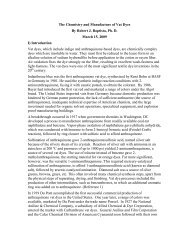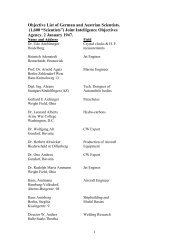International Dyestuff Industry - ColorantsHistory.Org
International Dyestuff Industry - ColorantsHistory.Org
International Dyestuff Industry - ColorantsHistory.Org
You also want an ePaper? Increase the reach of your titles
YUMPU automatically turns print PDFs into web optimized ePapers that Google loves.
Germany 64.8<br />
Switzerland 16.4<br />
United States 8.3<br />
Great Britain 4.1<br />
France 3.3<br />
Czechoslovakia 1.0<br />
The Netherlands 0.9<br />
Italy 0.6<br />
Belgium 0.4<br />
Poland 0.2<br />
Source for Tables VI and VII: Harm G. Schroter, “Cartels as a Form of Concentration in<br />
<strong>Industry</strong>: The Example of the <strong>International</strong> <strong>Dyestuff</strong>s Cartel from 1927 to 1939,” German<br />
Yearbook on Business History 1988 (Springer Verlag: Berlin, 1990), pp. 113-144. . Within a<br />
year, however, cartel arrangements were initiated by the two largest exporting nations,<br />
Germany and Switzerland. These were favored by new and existing national corporations<br />
and partnerships. The Germans, Swiss, and French (whose industry was controlled by<br />
Kuhlmann), linked up in 1928, and in 1932 they were joined by ICI. The British firm was,<br />
throughout the discussions, under pressure to take over its smaller British rivals. It did, in<br />
fact, acquire the British Alizarine Company in 1931, and exerted influence on most other<br />
firms. However, L.B. Holliday, which was responsible for a quarter of British exports, had<br />
rejected all advances. By increasing the production of certain dyes, Holliday was able to<br />
bring about the withdrawal of the import license on those specific colorants. ICI and IG<br />
Farben were infuriated, and in response jointly set up the Trafford Chemical Co. in 1938 so<br />
that IG Farben’s colors could be manufactured in Britain.<br />
Antitrust legislation prevented penetration of the United States market by the European<br />
cartel. The European answer was the setting up of German and Swiss factories in North<br />
America, where the tariff wall was also a serious obstacle to imports. However, the Great<br />
Depression held back progress for all participants. The turnover of Du Pont, for example, fell<br />
from $214m in 1929, to $127m in 1932.<br />
It is interesting to note that the Soviet Union, despite a shortage of raw materials, was<br />
producing 10,000 tons of dyes each year for the home market in newly opened and former<br />
Swiss and German factories near Moscow. After the Revolution of 1918 the Bureau for<br />
Aniline Manufacture was established, and two years later it controlled seven factories<br />
specializing mainly in sulfur and azo dyes. By this time, German dyes were imported in<br />
considerable amounts.<br />
The second half of the 1930s saw considerable improvement in growth. In 1938, ICI had<br />
around 60 percent of British sales, the CIBA- owned Clayton Aniline around 25 percent, and<br />
L.B. Holliday just under 15 percent. The Swiss, almost completely export oriented, had<br />
retained their positions, and their community of interests. CIBA was the major dye-maker;<br />
combined turnovers of Chemische Fabrik vorm. Sandoz (Sandoz AG from 1939) and J.R.<br />
Geigy AG did not equal that of CIBA. The latter specialized in vat dyes, and Sandoz in<br />
anthraquinone derivatives.<br />
Minor Swiss firms were Chemische Fabrik Rohner AG, a family business formed in 1906 at<br />
Pratein, and Durand & Huguenin AG, which reprocessed IG Farben dyes. Geigy had<br />
interests at Grenzach and Rouen, while CIBA, which from 1919 totally owned Clayton<br />
Aniline, retained its St. Fons factory. IG Farben held half the share capital in Durand &





